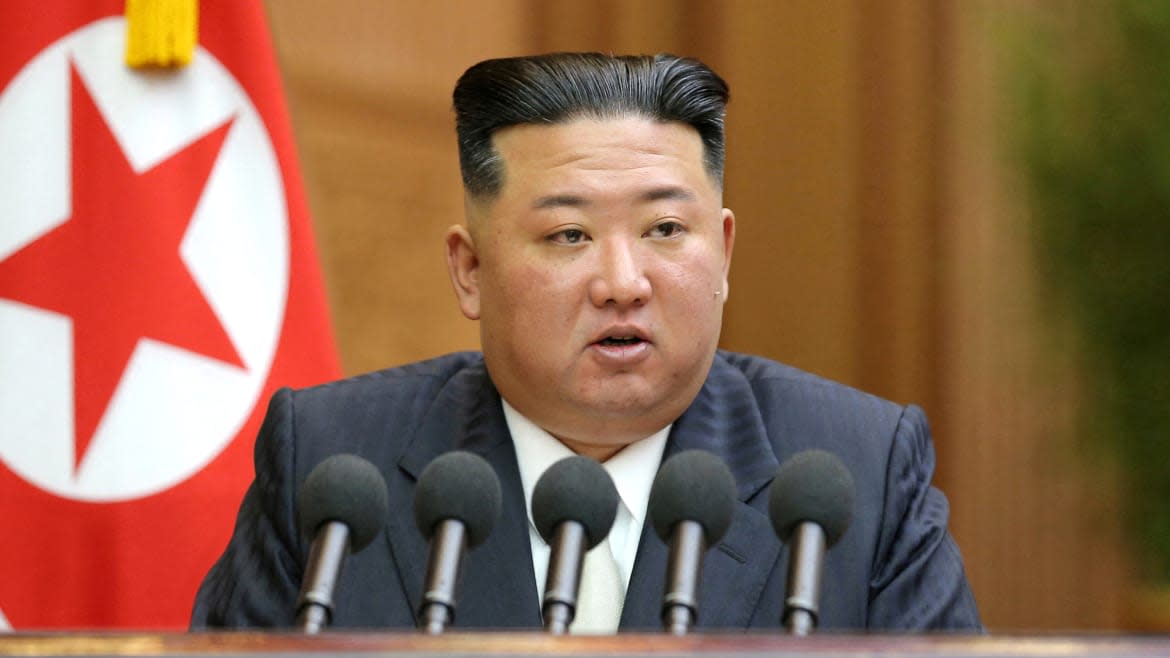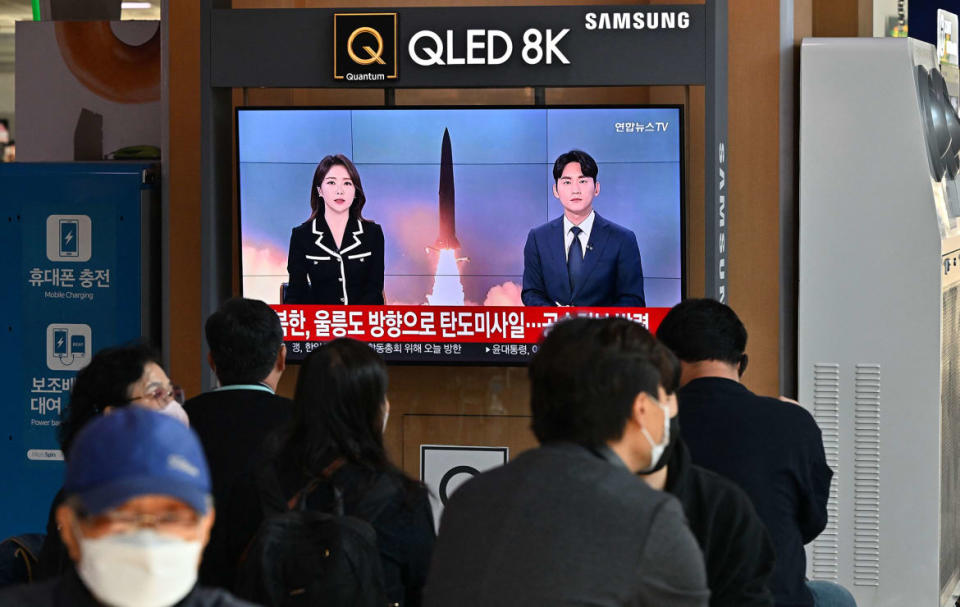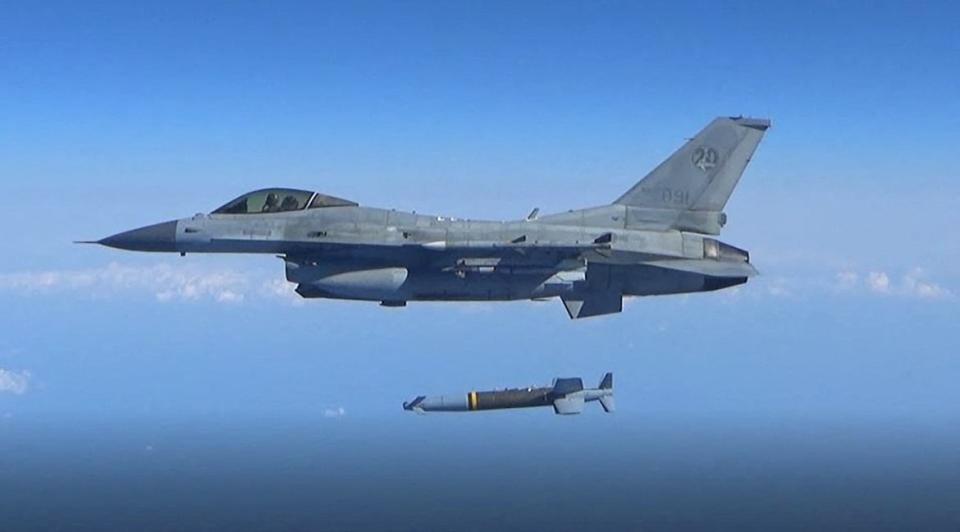Kim Jong Un Inches Closer to All-Out War Than Ever Before

They’re playing war games on both sides of the North-South line between the two Koreas, coming close to the real thing but stopping short of killing their enemies.
First there were the U.S. and South Korean warplanes, more than 240 of them led by F-35s configured for both their air forces, then the North Korean warnings of retribution, followed by volley after volley of North Korean missile and cannon shots.
North Korean gunners kept up the beat Thursday, launching an intercontinental ballistic missile of the sort that could theoretically carry a warhead to the U.S.
The missile did not fly over Japan, as originally feared, but dramatized the North’s strategy of intimidating the U.S. and its two northeast Asian allies, Japan and South Korea, as people in Japan’s northern prefectures were urged to look for shelter. North Korea also fired two more short-range missiles on top of all those fired Wednesday.
With each shot it seemed as though war was edging closer, especially after two North Korean shots made waves south of what’s called the Northern Limit Line below which North Korean ships are banned.
North Korea doesn’t recognize the dotted lines on maps drawn by the Americans and South Koreans after the Korean War had ended, and they proved it Wednesday with a missile shot near an obscure South Korean island named Ulleungdo 75 miles off the east coast—enough to set off air raid sirens on the island. That also provoked the South into test-firing a few of its own missiles and getting South Korea’s President Yoon Suk-yeol vowing the North would pay “a clear price for the provocations.”
But how far would the North Koreans be willing to go? And would Kim Jong Un follow up by ordering the North’s seventh nuclear test, his first since September 2017?
The Secret Weapons Scheme Spiraling Under America’s Nose
“I frankly don’t know,” said Joseph DeTrani, a veteran American negotiator who had gone head to head with the North Koreans before they cut off all talk more than a decade ago. DeTrani insisted, however, that the U.S. and South Korea should stick to their guns, insisting on “complete denuclearization” though Kim has made totally clear how much he loves his nukes and missiles.
Kim Jong Un has been talking of late about “tactical nukes” capable of hitting small targets like a bridge or an airfield, but North Korea does far better with plain old artillery shells, about 100 of which North Korean gunners fired off its east coast into what both sides had agreed would be a “buffer zone” between the them.
In fact, the North is so good at making them they’re “secretly” selling them to Russia, according to John Kirby, White House National Security Council spokesman. That transaction fits in perfectly with Kim’s avowed total support for Russian President Vladimir Putin’s invasion of Ukraine, for which he was reported earlier to be considering sending North Korean troops.

People watch a television screen showing a news broadcast with file footage of a North Korean missile test at a railway station in Seoul on Nov. 2, 2022.
The North Koreans, of course, had provided plenty of warning of what they might do if the U.S. and South Koreans went through with this week’s exercise. As the U.S. and South Korea sent war planes zipping close to the demilitarized zone, the North’s foreign ministry warned ominously of “more powerful follow-up measures.”
For the U.S. and South Korea, though, defiance was the operative word, all in accordance with President Yoon’s policy of getting tough with the North after five years of failed efforts at appeasement by his liberal predecessor.
U.S. and South Korean warplanes were making just that point, taking off from several different bases, supporting marines and soldiers on the ground, showing what they might do if Kim Jong Un went another fateful step and actually ordered a strike against the South as he had been threatening. In a display of aerial might, American heavy-duty B52 and B1 bombers based in Guam and Japan were also expected to join the parade, fueled in flight by an Australian KC30A tanker plane in a show of allied solidarity.
The war games—the biggest U.S. and South Korean aerial display since the first few years after the Korean War—matched the North Koreans’ biggest display of their growing expertise with missiles.
Having already test-fired more than 40 missiles this year, Kim had his forces fire at least 25 more shots of short and mid-range models as evidence he could easily hit American and South Korean bases. The most obvious target would be Camp Humphreys, the largest overseas U.S. base, headquarters for the 28,500 U.S. troops now in South Korea. Several miles away from Humphreys is Osan Air Base, headquarters of the U.S. Seventh Air Force, from which most of the planes were flying.
The war games, first the U.S. and South Korean aerial show of force and then the North Korean response, abruptly diverted attention from a week-long period of mourning in South Korea for the 156 people, 101 women, and 55 men—mostly kids in their twenties, also a few teens and one middle-schooler—who died in the Halloween crush in Seoul’s booming Itaewon district, the playground of GI’s before the U.S. and United Nations Command moved to Camp Humphreys, 40 miles south of Seoul, four years ago.

A South Korean Air Force F-15K fires an air-to-surface missile toward the north of its maritime border with North Korea, in this handout provided by South Korea’s Defense Ministry on Nov. 2, 2022.
Yoon had no sooner expressed his deepest condolences and lashed into the police for not anticipating the holiday mob of 100,000 and failing to move faster to rescue the victims than he was issuing statements and convening “emergency” meetings to see what to do about the North Koreans.
But would the U.S. and South Korean war games really accomplish much in bringing Kim Jong Un back to negotiations, much less giving up his precious nukes?
U.S. Vows to Teach Kim Jong Un a Lesson After Missile Over Japan
“Over 240 aircraft, many of them F-35s, will be flying 1,300-1,400 combat sorties,” said Evans Revere, a retired senior U.S. diplomat with years of experience in Korea. “I don’t think that will escape Pyongyang’s notice.”
Yes, he told The Daily Beast, “this is similar (although MUCH larger) to things we’ve done in the past.” Still, he said, “by increasing the scope and frequency of our exercises, we are placing a major burden on the N.K. regime, which will have to respond, use a lot of precious fuel, fly (and break) airplanes, expend missiles, etc.”
“Every time we move, they have to move, and they can ill afford to do so,” said Revere. “If we can keep this up, it will greatly increase the cost to N.K. of its current course. And if we can add new overt and covert economic measures after the nuke test, it could inflict a lot of pain on their system. ”
Get the Daily Beast's biggest scoops and scandals delivered right to your inbox. Sign up now.
Stay informed and gain unlimited access to the Daily Beast's unmatched reporting. Subscribe now.

